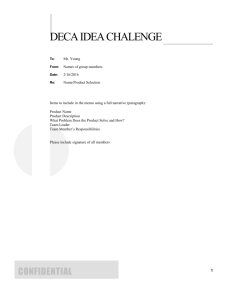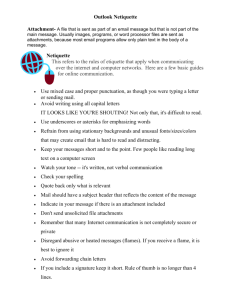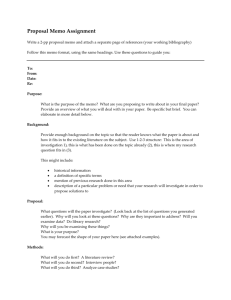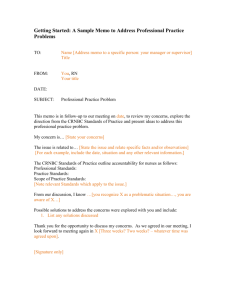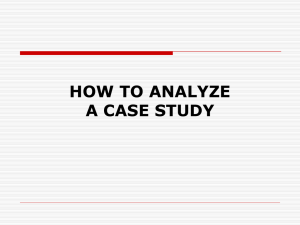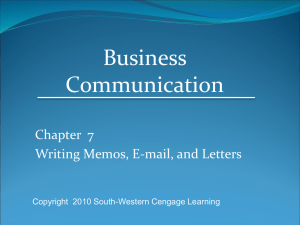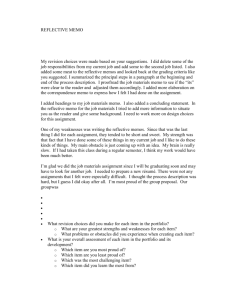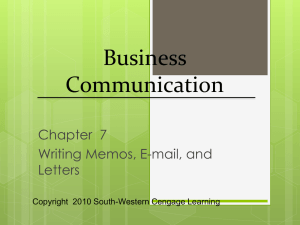Memorandums
advertisement
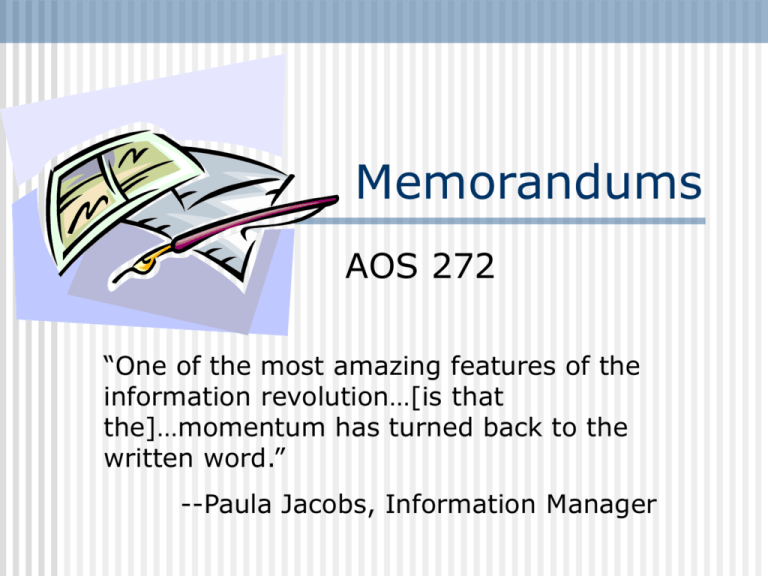
Memorandums AOS 272 “One of the most amazing features of the information revolution…[is that the]…momentum has turned back to the written word.” --Paula Jacobs, Information Manager Memorandums Memorandums (memos) are used for internal business communication. Their standardized format saves time and focuses on content. They are often less formal because writer and receiver know each other. Memo Format 2-inch top margin, standard side and bottom margins. Guide words all caps and bold. MEMO TO: FROM: DATE: SUBJECT: Tab to align information after guide words Memorandum To: Staff From: Don Barstow Date: September 16, 2002 Re: Office Safety Please mark your calendars for the Office Safety Meeting on September 27 at 3:00 p.m. All staff are invited. Confidential Memo Heading Most companies have a standardized memo format with company logo. Word processing software have templates. Addressee Courtesy titles generally not used. Business titles used for respect or to eliminate confusion. Use distribution list for many recipients. Distribution List Distribution: J. Bailey S. Craig J. Donovan P. Finley Writer’s Information No courtesy title. May include business title for clarity. Include information needed for response: Department Location Phone number Mail code Date and Subject Date written out September 27, 2002 is standard American format. Subject Line: Brief Specific Capitalize main words Body One blank line between heading and body. Single space paragraphs; double space between. Use block format (no indents) Notations Reference initials: Lowercase initials of person who keyed. File name Attachment notation [Attachment] Enclosure notation [Enclosure] Copy notation c: J. Jones E-Mail and Netiquette E-Mail or Snail Mail? E-mail is now more popular than postal mail More than 90%of major U.S. companies use email. Advantages and Disadvantages Eliminates telephone tag Can be used to contact multiple readers Inexpensive Not confidential Doesn’t transfer emotional or nonverbal cues Subject to technical failures Can be ignored The Seven Cs of Business Communication Clear Concise Concrete Courteous Coherent Correct Complete Netiquette for E-mail: 1. 2. 3. 4. Reading your work e-mail is a professional responsibility just like answering your phones. Read and answer e-mail at least three times a day. If you can’t, use answermail or vacation features that let you send an automatic message responding to every message you get. You can let readers know you’ll be out and won’t respond to email until a certain date. You can also give a limited access password to someone to return your e-mail message and change it when you return. More Info on Email http://familyinternet.about.com/cs/e mail/a/aaemailetiquett.htm Professionalism 1. 2. 3. When you introduce yourself via email, not only are you making a first impression, you're also leaving a written record. Think before you write and read the message carefully before sending. Use spell-check and proofread! Professionalism Use an appropriate greeting Be cautious with humor Use closing or signature block that gives needed information Courtesy in Email Don't send anything over e-mail that you wouldn't want published on the front page of USA Today. Assume that e-mail is NEVER confidential, even if you ask for it to be. Don’t use e-mail to resolve conflicts or say things that you wouldn’t say in person. Avoid anger and sarcasm, and be cautious with humor – it may be misinterpreted. Coherence Map out your main points Organize – don’t be afraid to cut and paste Conciseness Use e-mail for delivery of urgent information. Keep messages brief and to the point. Respect other people's time -- and send e-mail only when it needs to be sent Complete Contains all requested information Answers any questions Include the attachment! Other Considerations Protect yourself: Remember to save copies -- on paper, on your own workstation, or both -- of your own important e-mail messages. Netiquette does forbid spreading misinformation, personal or confidential information, or any statement that is needlessly damaging to others -including businesses. Courtesy in Memos Use a subject heading that gives pertinent information Be considerate of reader’s time – get to the point. Use formatting (bullets, bold) to highlight key points. Try to include all the necessary information without wandering or rambling. Use the subject line to let the reader know what the message is addressing. Coherence in Memos Introduction Body Gets reader’s attention Gives reasons to continue Fulfills the purpose of the memo Gives complete and accurate details Conclusion Specifies action needed Closes with goodwill Audience Analysis Communication Styles Thinkers Logical Reflective Want facts and analysis Feelers People-centered Empathetic Courtesy is important Sensers Action based Direct Get to the point Intuitors Big-picture Visionaries Use originality Seek their ideas

